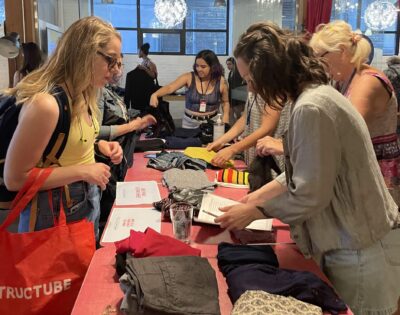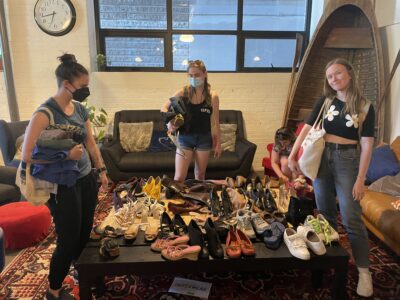This March, The Good Swap is celebrating the two-year anniversary of its first monthly clothing swap in Toronto. Since then, the swaps have given thousands of gently used clothing items new homes—eliminating textile waste while helping community members update their wardrobes and save money.
Lisa Amerongen has always been a big fan of vintage clothing, thrift stores, and swaps—but not of the fashion industry’s wasteful and unethical practices. So, in March 2022, looking for a way to take action, she gathered some friends, got the word out, and hosted the first edition of The Good Swap at The Centre for Social Innovation in downtown Toronto.
“It was a big experiment! It turned out the timing was right: people were excited to be back in the world, were looking for ways to green their wardrobes, and the event sold out,” Amerongen says.
Since then, The Good Swap has grown, racking up 150+ registrants per event, and regularly selling out. Over two years, they’ve hosted 26 events that have been attended by over 1550 individuals, and over 20,000 items have been swapped, donated, or recycled.

The premise of the swaps is simple: attendees of all genders, bodies, and ages can bring up to 10 items of preloved clothing, footwear, jewelry, and accessories in good condition to the swap. In return, they can browse through the donated clothes and take home some items they love.
“If you want to make a positive change, swapping is a great way to start,” says Amerongen. “All the dopamine without the dilemma!”
The fashion industry is a huge culprit for environmental harm and unethical business models. 1.2 billion tonnes of global carbon emissions are caused by global textile production every year. Three of five fast fashion garments end up in a landfill within a year of purchase. In 2020, Fashion Checker found that 93% of the brands surveyed did not pay garment workers a living wage, and most worked in unsafe conditions.
Swapping is an example of a circular economy, a closed-loop system that leads us to use what we already have, instead of making more.

“People are consciously – or unconsciously – influenced by a market-driven bias that claims “new is best.” We’re fed advertisements constantly. We’re made to feel that ownership and upgrades are essential to our personhood,” Amerongen says. “So, if you’ve bought into the “new is best” paradigm, swapping won’t feel like an acceptable option.”
But she thinks the tide is changing, and more people are realizing the negative impacts of their shopping habits on the environment and garment workers—and their wallets.
“People realize that the need to buy new items is entirely manufactured by global marketing and sales teams,” she says. “There are so many ways to curate your style without overconsuming.”
Amerongen tells us that word-of-mouth alone has been huge in spreading the word about The Good Swap. Over two years, she’s established a devoted community dedicated to conscious clothing consumption. At the swaps, she strives to cultivate a relaxed, judgment-free atmosphere where people are free to experience the joy of clothes swapping.
“It’s a lively buzz of people browsing, friends assessing fits, volunteers folding clothes, and strangers saying, ‘Oh, that used to be mine, it looks so good on you!'”

With their second-anniversary swap happening on March 23, Amerongen is excited to keep hosting clothing swaps in the GTA and beyond.
“I hope we continue to bring new life to the clothes that are languishing in the back of your – yes, your – closet, give you some new-to-you items to love, and reduce textile waste in the city.”
Wondering how you can take steps towards more conscious clothing consumption? We asked Amerongen for some of her best tips— from swapping to beyond.
Reduce
- Throw a swap event with friends (DM @t.o.thegoodswap if you want some tips!)
- Be a proud outfit repeater
- #LovedClothesLast: invest in your clothing by treating items with care, mending them when you need to
- Make it yourself! Sew, knit, crotchet, weave.
Shopping
- Buy from online resellers, local thrift and consignment stores; there’s so much to choose from!
- Vote with your dollars: You can still shop! Just do it consciously. Your money is powerful, and where you choose to spend it matters.
- Ask questions: Who made your clothes? How? Where? In what conditions? If you aren’t comfortable with answers, walk away!
- Calculate before you buy: How many times will you wear it? If the answer is “not many, ” borrow, swap, or thrift!
Learn
- Listen to the Clotheshorse and Conscious Style podcasts.
- Read The Day the World Stops Shopping (right now!)
- Follow everything Fashion Takes Action does
- Check out apps like Good on You and Leaping Bunny to see brands’ environmental and ethical scores before deciding to buy from them.
- Look for repair and upcycle workshops like those offered at The Workroom, Toronto Tool Library, Textile Museum of Canada, Repair Cafe, and Creative Reuse Toronto.
Volunteer
- Become a Remake Ambassador
- Join your local Fashion Revolution chapter.
- Volunteer with The Good Swap (ha, but also, seriously)




 Follow Us On Instagram
Follow Us On Instagram
